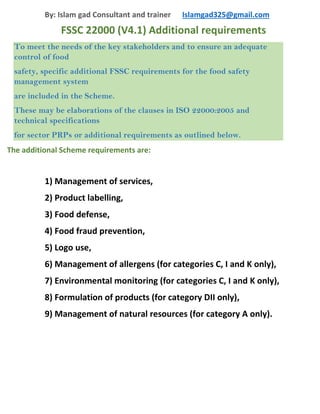Fssc 22000 (v4.1) additional requirements
- 1. By: Islam gad Consultant and trainer Islamgad325@gmail.com FSSC 22000 (V4.1) Additional requirements To meet the needs of the key stakeholders and to ensure an adequate control of food safety, specific additional FSSC requirements for the food safety management system are included in the Scheme. These may be elaborations of the clauses in ISO 22000:2005 and technical specifications for sector PRPs or additional requirements as outlined below. The additional Scheme requirements are: 1) Management of services, 2) Product labelling, 3) Food defense, 4) Food fraud prevention, 5) Logo use, 6) Management of allergens (for categories C, I and K only), 7) Environmental monitoring (for categories C, I and K only), 8) Formulation of products (for category DII only), 9) Management of natural resources (for category A only).
- 2. By: Islam gad Consultant and trainer Islamgad325@gmail.com Additional requirements Requirement 1) Management of services cluesat standard ( 2.1.4.1) Management of services 1) The organization in the food chain shall ensure that all services that may have an impact on food safety: a) have specified requirements which are regularly reviewed, b) are described in documents to the extent needed to conduct hazard analysis, c) are managed in conformance with the requirements of technical specification for sector PRPs, d) are assessed and approved demonstrating compliance with specified requirements, e) are monitored to assure continued service provider approval status. Management of services 2) The services referred to in 1) above shall include at least: a) utilities, b) transport and storage, c) maintenance, d) cleaning e) outsourced services Management of services 3) The organization shall implement a system to assure that when analysis critical to the verification of food safety is undertaken, this is conducted by a competent laboratory that has the capability to produce precise and repeatable test results using
- 3. By: Islam gad Consultant and trainer Islamgad325@gmail.com validated test methods and best practices (e.g. successful participation in proficiency testing programs, regulatory approved programs or accreditation to international standards such as ISO 17025). 2)Product labelling clues at standard ( 2.1.4.2 ) Product labelling The organization shall ensure that the finished product is labelled according to the applicable food regulations in the country of intended sale. 3)Food defense(2.1.4.3) 2.1.4.3.1 Threat assessment Threat assessment 1) The organization shall have a documented and implemented threat assessment procedure in place that: a) identifies potential threats, b) develops control measures, and c) prioritises them against the identified threats. 2) To identify the threats, the organization shall assess the susceptibility of its products to potential food defense acts. 2.1.4.3.2 Control measures The organization shall put in place appropriate control measures to reduce or eliminate the identified threats. 2.1.4.3.3 Plan 1) All policies, procedures and records are included in a food defense plan supported by the organization’s Food Safety Management System for all its products.
- 4. By: Islam gad Consultant and trainer Islamgad325@gmail.com 2) The plan shall comply with applicable legislation. 4)Food Fraud prevention(2.1.4.4) Vulnerability assessment (2.1.4.4.1) 1) The organization shall have a documented and implemented vulnerability assessment procedure in place that: a) identifies potential vulnerabilities, b) develops control measures, and c) prioritises them against the identified vulnerabilities To identify the vulnerabilities, the organization shall assess the susceptibility of its products to potential food fraud acts. Control measures 2.1.4.4.2 The organization shall put in place appropriate control measures to reduce or eliminate the identified vulnerabilities. Plan 2.1.4.4.3 1) All policies, procedures and records are included in a food fraud prevention plan supported by the organization’s Food Safety Management System for all its products. 2) The plan shall comply with applicable legislation. 5)Logo use(2.1.4.5) 1) Certified organizations are entitled to use the FSSC 22000 logo. The FSSC 22000 logo may be used on the organization’s printed matter, website and other promotional material subject to the following design specifications:
- 5. By: Islam gad Consultant and trainer Islamgad325@gmail.com 2) Use of the logo in black and white is permitted when all other text and imagines are in black and white. To avoid the impression that the CB has certified or approved any product, process or service supplied by the certified organization the FSSC 22000 logo is not allowed to be used on: a) a product, b) its labelling, c) its packaging, d) in any other manner that implies FSSC 22000 approves a product, process or service 6)Management of allergens (for categories C, I and K only)(2.1.4.6) Management of allergens 1) A documented allergen management plan shall be in place that includes: a) risk assessment addressing potential allergen cross contamination; b) control measures to reduce or eliminate the risk of cross contamination; c) validation and verification of effective implementation. 2) All finished products intentionally or potentially containing allergenic materials are labeled according to the allergen labelling regulations in the country of manufacture and country of destination
- 6. By: Islam gad Consultant and trainer Islamgad325@gmail.com 7)Environmental monitoring (for categories C, I and K only)(2.1.4.7) Environmental monitoring (for categories C, I and K only) The organization shall ensure that an environmental monitoring program is in place to verify the effectiveness of cleaning and sanitation programs which shall meet the verification requirements as described in ISO 22000. 8)Formulation of products (for sub-category DII, pet food for dogs and cats only)( 2.1.4.8) 1) Compounded pet food for dogs and cats shall be formulated in a manner that is consistent with the intended use of the product. 2) Formulation procedures shall be in place to manage the use of ingredients that contain nutrients that can have adverse animal health impact. 9)Management of natural resources (for category A only)( 2.1.4.9) 1) The organization (animal farm) shall: a) Identify the risks it exposes from animal production to both, i) animal health, and ii) public health. b) Assess the hazards that expose these risks derived from on-farm used natural resources (e.g. water and soil, to include water for animals, water for irrigation, on farm feed production for own animals). c) Put in place appropriate control measures to protect public and animal health.





